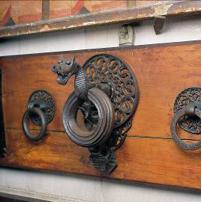'Gothic door knocker'. Casa de l’Ardiaca, Barcelona
Object:Gothic door knocker. Casa de l’Ardiaca, Barcelona
Date: Late 15th century
Technique: Openworked, forge-welded, filed and chiselled wrought iron
Dimensions: 210 x 345 x 120 mm
Collection: Former collection of Santiago Rusiñol. Museu Cau Ferrat, inventory no.: 30,987
Description and historical background:
The discovery of hydraulic bellows by Catalan blacksmiths in the 11th century, and the enormous boost they gave to the blacksmith’s craft, which has been known since then as Catalan ironwork, made iron one of the key materials in artistic creation in Catalonia from then onwards.
Hydraulic bellows provided a constant flow of air which made it possible to attain the highest temperatures in a smelting furnace. This made the iron more ductile and more malleable, but, above all, it enabled blacksmiths to produce longer bars which they could bend. The result was the famous Romanesque spiral, which was a completely new decorative element at the time.
Before Catalan ironwork had been developed, these very long wrought-iron bars were technically unfeasible. With its discovery, Catalan blacksmiths were able to create new shapes which they could apply to making grilles and decorative embellishments. These soon became key features of the Romanesque aesthetic.
The popularity of Catalan ironwork grew to such an extent that blacksmiths were called on to complete building work on some of Europe’s major landmarks. Between 1248 and 1250, the master blacksmiths, Blay and Suñol, made the wrought iron details on the doors of Notre-Dame in Paris, which we can still see today. They are one of the crowning achievements in the history of European ironwork.
- Log in to post comments


 Buy tickets
Buy tickets Buy tickets
Buy tickets



